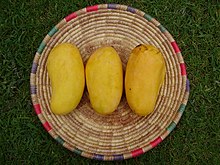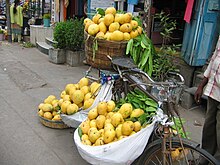Mango
This article needs additional citations for verification. (September 2013) |
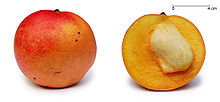
The mango is a juicy stone fruit belonging to the genus Mangifera, consisting of numerous tropical fruiting trees, that are cultivated mostly for edible fruit. The majority of these species are found in nature as wild mangoes. They all belong to the flowering plant family Anacardiaceae. The mango is native to South and Southeast Asia, from where it has been distributed worldwide to become one of the most cultivated fruits in the tropics. The highest concentration of Mangifera genus is situated in western part of Malesia (Sumatra, Java and Borneo) and in Burma and India.[1] While other Mangifera species (e.g. horse mango, M. foetida) are also grown on a more localized basis, Mangifera indica – the 'common mango' or 'Indian mango' – is the only mango tree commonly cultivated in many tropical and subtropical regions. It originated in India and Burma.[2] It is the national fruit of India and the Philippines and the national tree of Bangladesh.[3] In several cultures, its fruit and leaves are ritually used as floral decorations at weddings, public celebrations and religious ceremonies.[citation needed]

Description


Mango trees (Mangifera indica L.) grow up to 35–40 m (115–131 ft) tall, with a crown radius of 10 m (33 ft). The trees are long-lived, as some specimens still fruit after 300 years. In deep soil, the taproot descends to a depth of 6 m (20 ft), with profuse, wide-spreading feeder roots; the tree also sends down many anchor roots, which penetrate several feet of soil. The leaves are evergreen, alternate, simple, 15–35 cm (5.9–13.8 in) long and 6–16 cm (2.4–6.3 in) broad; when the leaves are young they are orange-pink, rapidly changing to a dark, glossy red, then dark green as they mature. The flowers are produced in terminal panicles 10–40 cm (3.9–15.7 in) long; each flower is small and white with five petals 5–10 mm (0.20–0.39 in) long, with a mild, sweet odor suggestive of lily of the valley. There are over 400 varieties of mango, many of which ripen in summer while some give double-crop.[4] The fruit takes three to six months to ripen.
The ripe fruit varies in size and color. Cultivars are variously yellow, orange, red or green, and carry a single flat, oblong pit that can be fibrous or hairy on the surface, and which does not separate easily from the pulp. Ripe, unpeeled mangoes give off a distinctive resinous, sweet smell. Inside the pit 1–2 mm (0.039–0.079 in) thick is a thin lining covering a single seed, 4–7 mm (0.16–0.28 in) long. The seed contains the plant embryo.
Etymology

The English word "mango" (plural "mangoes" or "mangos") originated from the Malayalam word māṅga via Portuguese (also manga) during spice trade with Kerala in 1498 [5][6] The word's first recorded attestation in a European language was a text by Ludovico di Varthema in Italian in 1510, as manga; the first recorded occurrences in languages such as French and post-classical Latin appear to be translations from this Italian text. The origin of the "-o" ending in English is unclear.[7] Mango is also mentioned by Hendrik van Rheede the Dutch commander of Malabar(Northern Kerala) in his book Hortus Malabaricus, a compendium of the plants of economic and medical value in the Malabar, published in 1678.[8] When mangoes were first imported to the American colonies in the 17th century, they had to be pickled due to lack of refrigeration. Other fruits were also pickled and came to be called "mangoes", especially bell peppers, and by the 18th century, the word "mango" became a verb meaning "to pickle".[9]
Cultivation

Mangoes have been cultivated in South Asia for thousands of years[10] and reached East Asia between the fifth and fourth centuries BC. By the 10th century AD, cultivation had begun in East Africa.[10] The 14th century Moroccan traveler, Ibn Battuta, reported it at Mogadishu.[11] Cultivation came later to Brazil, the West Indies and Mexico, where an appropriate climate allows its growth.[10]
The mango is now cultivated in most frost-free tropical and warmer subtropical climates; almost half of the world's mangoes are cultivated in India alone, with the second-largest source being China.[12][13][14] Mangoes are also grown in Andalusia, Spain (mainly in Málaga province), as its coastal subtropical climate is one of the few places in mainland Europe that allows the growth of tropical plants and fruit trees. The Canary Islands are another notable Spanish producer of the fruit. Other cultivators include North America (in South Florida and California's Coachella Valley), South and Central America, the Caribbean, Hawai'i, south, west and central Africa, Australia, China, Pakistan, Bangladesh, and Southeast Asia. Though India is the largest producer of mangoes, it accounts for less than one percent of the international mango trade; India consumes most of its own production.[15]
Many commercial cultivars are grafted on to the cold-hardy rootstock of Gomera-1 mango cultivar, originally from Cuba. Its root system is well adapted to coastal Mediterranean climate.[16] Many of the 1,000+ mango cultivars are easily cultivated using grafted saplings, ranging from the "turpentine mango" (named for its strong taste of turpentine[17]) to the huevos de toro.[citation needed] Dwarf or semi-dwarf varieties serve as ornamental plants and can be grown in containers. A wide variety of diseases can afflict mangoes; see List of mango diseases.
Food
Mangoes are generally sweet, although the taste and texture of the flesh varies across cultivars, some having a soft, pulpy texture similar to an overripe plum, while others firmer, like a cantaloupe or avocado and some may have a fibrous texture. For consumption of unripe, pickled or cooked fruit, its skin can be consumed but has potential to cause contact dermatitis of the lips, gingiva or tongue in susceptible people.
Cuisine

Mangoes are widely used in cuisine. Sour, unripe mangoes are used in chutneys, athanu, pickles,[18] side dishes, or may be eaten raw with salt, chili, or soy sauce. A summer drink called Aam panna comes from mangoes. Mango pulp made into jelly or cooked with red gram dhal and green chillies may be served with cooked rice. Mango lassi is popular throughout South Asia,[19] prepared by mixing ripe mangoes or mango pulp with buttermilk and sugar. Ripe mangoes are also used to make curries. Aamras is a popular thick juice made of mangoes with sugar or milk, and is consumed with chapatis or pooris. The pulp from ripe mangoes is also used to make jam called mangada. Andhra Aavakaaya is a pickle made from raw, unripe, pulpy and sour mango, mixed with chilli powder, fenugreek seeds, mustard powder, salt and groundnut oil. Mango is also used in Andhra to make Dal preparations. Gujaratis use mango to make chunda (a grated mango delicacy)
Mangoes are used in preserves such as moramba, amchur (dried and powdered unripe mango) and pickles, including a spicy mustard-oil pickle and alcohol. Ripe mangoes are often cut into thin layers, desiccated, folded, and then cut. These bars are similar to dried guava fruit bars available in some countries. The fruit is also added to cereal products such as muesli and oat granola. Mangoes are often prepared charred in the American state of Hawaii.
Unripe mango may be eaten with bagoong (especially in the Philippines), fish sauce or with dash of salt. Dried strips of sweet, ripe mango (sometimes combined with seedless tamarind to form mangorind) are also popular. Mangoes may be used to make juices, mango nectar, and as a flavoring and major ingredient in ice cream and sorbetes.

Mango is used to make juices, smoothies, ice cream, fruit bars, raspados, aguas frescas, pies and sweet chili sauce, or mixed with chamoy, a sweet and spicy chili paste. It is popular on a stick dipped in hot chili powder and salt or as a main ingredient in fresh fruit combinations. In Central America, mango is either eaten green mixed with salt, vinegar, black pepper and hot sauce, or ripe in various forms. Toasted and ground pumpkin seed (called pepita) with lime and salt are the norm when eating green mangoes. Some people also add soy sauce or chili sauce.
Pieces of mango can be mashed and used as a topping on ice cream or blended with milk and ice as milkshakes. Sweet glutinous rice is flavored with coconut, then served with sliced mango as a dessert. In other parts of Southeast Asia, mangoes are pickled with fish sauce and rice vinegar. Green mangoes can be used in mango salad with fish sauce and dried shrimp. Mango with condensed milk may be used as a topping for shaved ice.
Nutrients and phytochemicals
 and in cross section | |||||||||||||||||||||||||||||||||||||||||||||||||||
| Nutritional value per 100 g (3.5 oz) | |||||||||||||||||||||||||||||||||||||||||||||||||||
|---|---|---|---|---|---|---|---|---|---|---|---|---|---|---|---|---|---|---|---|---|---|---|---|---|---|---|---|---|---|---|---|---|---|---|---|---|---|---|---|---|---|---|---|---|---|---|---|---|---|---|---|
| Energy | 250 kJ (60 kcal) | ||||||||||||||||||||||||||||||||||||||||||||||||||
15 g | |||||||||||||||||||||||||||||||||||||||||||||||||||
| Sugars | 13.7 | ||||||||||||||||||||||||||||||||||||||||||||||||||
| Dietary fiber | 1.6 g | ||||||||||||||||||||||||||||||||||||||||||||||||||
0.38 g | |||||||||||||||||||||||||||||||||||||||||||||||||||
0.82 g | |||||||||||||||||||||||||||||||||||||||||||||||||||
| |||||||||||||||||||||||||||||||||||||||||||||||||||
| †Percentages estimated using US recommendations for adults,[20] except for potassium, which is estimated based on expert recommendation from the National Academies.[21] | |||||||||||||||||||||||||||||||||||||||||||||||||||
The energy value per 100 g (3.5 oz) is 250 kJ (60 kcal), and that of the apple mango is slightly higher (79 kcal per 100g). Mango contains a variety of phytochemicals[22] and nutrients.[23]
Mango peel and pulp contain other compounds, such as pigment carotenoids and polyphenols, and omega-3 and -6 polyunsaturated fatty acids.[24]
Although not confirmed scientifically, mango peel pigments may have biological effects,[22][25] including carotenoids, such as the provitamin A compound, beta-carotene, lutein and alpha-carotene,[26] polyphenols[27][28] such as quercetin, kaempferol, gallic acid, caffeic acid, catechins, tannins, and the unique mango xanthonoid, mangiferin,[29] which are under preliminary research for their potential to counteract various disease processes.[30][31] Phytochemical and nutrient content appears to vary across mango cultivars.[32] Up to 25 different carotenoids have been isolated from mango pulp, the densest of which was beta-carotene, which accounts for the yellow-orange pigmentation of most mango cultivars.[33] Peel and leaves also have significant polyphenol content, including xanthonoids, mangiferin and gallic acid.[34]
The mango triterpene, lupeol,[35] is an effective inhibitor in laboratory models of prostate and skin cancers.[36][37][38] An extract of mango branch bark called Vimang, isolated by Cuban scientists, contains numerous polyphenols with antioxidant properties in vitro[39] and on blood parameters of elderly humans.[40]
The pigment euxanthin, known as Indian yellow, is often thought to be produced from the urine of cattle fed mango leaves; the practice is described as having been outlawed in 1908 due to malnutrition of the cows and possible urushiol poisoning.[41] This supposed origin of euxanthin appears to rely on a single, anecdotal source, and Indian legal records do not outlaw such a practice.[42]
Flavor

The flavor of mango fruits is constituted by several volatile organic chemicals mainly belonging to terpenes, furanones, lactones and ester classes. Different varieties or cultivars of mangoes can have flavor made up of different volatile chemicals or same volatile chemicals in different quantities.[43][44] In general, New World mango cultivars are characterized by the dominance of δ-3-carene, a monoterpene flavorant; whereas, high concentration of other monoterepnes such as (Z)-ocimene and myrcene as well as the presence of lactones and furanones is the unique feature of Old World cultivars.[44][45][46] In India, the country of origin and diversification of mango, Alphonso (mango) is one of the most popular cultivars. In Alphonso mango, the lactones and furanones are sysnthesized during ripening; whereas, terpenes and the other flavorants are present in both the developing (immature) as well as ripening fruits.[47][48][49][50] Ethylene, a ripening-related hormone well known to be involved in ripening of mango fruits, causes changes in the flavor composition of mango fruits upon exogenous application as well.[51][52] In contrast to the huge amount of information available on the chemical composition of mango flavor, the biosynthesis of these chemicals has not been studied in depth; only a handful of genes encoding the enzymes of flavor biosynthetic pathways have been characterized to date.[53][54][55][56]
Potential for contact dermatitis
Contact with oils in mango leaves, stems, sap, and skin can cause dermatitis and anaphylaxis in susceptible individuals.[57] It contains mangiferen, resinous acid, mangiferic acid, and the resinol called mangiferol. Those with a history of contact dermatitis induced by urushiol (an allergen found in poison ivy, poison oak, and poison sumac) may be most at risk for mango contact dermatitis.[58] Cross-reactions between mango allergens and urushiol have been observed.[59] Urushiol is also present in mango leaves and stems. During its primary ripening season, it is the most common cause of plant dermatitis in Hawaii.[60] After contacting it, reactions may not be immediate. Eyelids, face, or other parts of the body may even swell because of this. It irritates the skin and may even blister the skin. Also, burning of the mango wood, leaves, etc. should be avoided because fumes could be dangerous.[citation needed]
Cultural significance

The mango is the national fruit of India[61] and the Philippines. It is also the national tree of Bangladesh.[62] In India, harvest and sale of mangoes is during March–May and this is annually covered by news agencies. "Frooti" is an Indian mango drink and the Coca-Cola company started their own drink, called "Maaza", in order to compete with it.[63]
The Mughal emperor Akbar (1556-1605 AD) is said to have planted a mango orchard having 100,000 trees in Darbhanga, eastern India.[64] The Jain goddess Ambika is traditionally represented as sitting under a mango tree.[65] In Hinduism, the perfectly ripe mango is often held by Lord Ganesha as a symbol of attainment, regarding the devotees potential perfection. Mango blossoms are also used in the worship of the goddess Saraswati. No Telugu/Kannada New Year's Day called Ugadi passes without eating ugadi pachadi made with mango pieces as one of the ingredients.
Dried mango skin and its seeds are also used in Ayurvedic medicines.[18] Mango leaves are used to decorate archways and doors in Indian houses and during weddings and celebrations like Ganesh Chaturthi. Mango motifs and paisleys are widely used in different Indian embroidery styles, and are found in Kashmiri shawls, Kanchipuram silk sarees, etc. Paisleys are also common to Iranian art, because of its pre-Islamic Zoroastrian past.
In Tamil Nadu, the mango is referred to as one of the three royal fruits (Mukkani-முக்கனி) along with banana and jackfruit, for their sweetness and flavor.[66] This triad of fruits is also referred to as Ma-pala-vazhai (மா-பலா-வாழை).
Famous Urdu poet Mirza Asadullah Khan Ghalib was very fond of mangoes. There are many anecdotes concerning his love for mangoes.[67] Rabindranath Tagore was fond of mangoes and has written poems about its flowers- aamer monjori. Poet Sa'd Bin Ard has written some poems about mangoes.
In the West Indies, the expression "to go mango walk" means to steal another person's mango fruits. This is celebrated in the famous song, The Mango Walk.
In Australia, the first tray of mangoes of the season is traditionally sold at an auction for charity.[68]
The Classical Sanskrit poet Kālidāsa sang the praises of mangoes.[69]
Production and consumption
The Food and Agriculture Organization of the United Nations estimates worldwide production at nearly 38,600,000 tonnes (42,500,000 short tons) in 2011 (table below). India is the biggest producer of mangoes with nearly 40% of world's production. Controlling attacks of mango mealybugs on fruiting mango trees, however, is a major challenge.
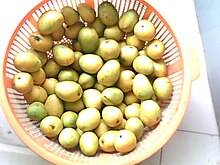
from Bangladesh
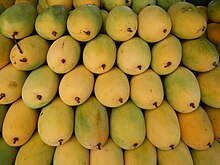
| Country/State | Production in millions of tons | |||
|---|---|---|---|---|
| World total | ||||
|
| ||||
Cultivars
This section needs additional citations for verification. (May 2013) |

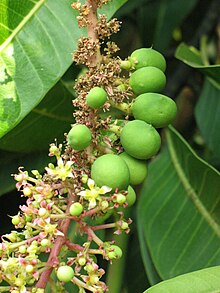
Many hundreds of named mango cultivars exist. In mango orchards, several cultivars are often crossed to improve pollination. Many desired cultivars are monoembryonic and must be propagated by grafting or they do not breed true. A common mono-embryonic cultivar is Alphonso, an important export product, considered as "the king of mangoes".[63]
Cultivars that excel in one climate may fail elsewhere. For example, Indian cultivars such as Julie, a prolific cultivar in Jamaica, require annual fungicide treatment to escape a lethal fungal disease known as anthracnose in Florida. Asian mangoes are resistant to anthracnose.
The current world market is dominated by the cultivar Tommy Atkins, a seedling of Haden that first fruited in 1940 in southern Florida, U.S. It was initially rejected commercially by Florida researchers.[71] For example, 80% of mangoes in UK supermarkets are Tommy Atkins. Despite its fibrous flesh and only fair taste,[citation needed] growers worldwide have embraced the cultivar for its exceptional productivity and disease resistance, shelf life, transportability, size and appealing color.
Alphonso, Benishaan and Kesar mango varieties are popular varieties in India's southern states, while the Chaunsa variety, among others, is popular in the northern states and Pakistan.
Guatemala markets sell a variety called 'mango de leche' which is more resinous outside and inside.
Generally, ripe mangoes have an orange-yellow or reddish peel and are juicy for eating, while exported fruit are often picked while underripe with green peels. Although producing ethylene while ripening, unripened exported mangoes do not have the same juiciness or flavor as fresh fruit.
Like other drupaceous fruits, mangoes come in both freestone and clingstone varieties.
Gallery
-
Mangoes for sale at a supermarket
-
Unripe mangoes on a mango tree
-
Mango tree with flowers
-
Mature Mangifera indica after annual flowering, note the budding fruits and residual flowers.
-
Immature fruit of Mangifera, approximately six weeks after annual flowering
-
A view of Mangifera indica in Southern India
-
A mango stand in Merritt Island, Florida
-
A nearly ripened purple mango, Israel
-
Mangoes being sold in the Philippines
-
Green mangoes of the Philippines
-
Green mango of Bangladesh
-
A mango grown in Bangladesh
-
Mango roundabout, Rajshahi, Bangladesh
-
Saigon mangoes on display at the 15th Annual International Mango Festival at the Fairchild Tropical Botanic Garden, Florida, United States
-
Mango-Slice
-
Sidur Mango of Bangladesh
-
Sindur Mango of Bangladesh
-
Ripe Mango
-
Mango Close View
See also
- Aavakaaya South India pickled mango
- Achaar, South Asian pickles, commonly containing mango and lime
- Amchoor, mango powder
- Mangosteen, an unrelated fruit with a similar name
- Mango mealybug
References
- ^ , Morton J, 1987. Fruits of warm climates.
- ^ , Kostermans AJHG, Bompard JM, 1993. The Mangoes: Their Botany, Nomenclature, Horticulture and Utilization.
- ^ "Mango tree, national tree". 2010-11-15. Retrieved 2013-11-16.
- ^ "Mango (MANGIFERA INDICA) varieties". toptropicals.com. Retrieved 2 January 2014.
- ^ Mango Merriam Webster Dictionary.
"Origin of mango: Portuguese manga, probably from Malayalam māṅga. First Known Use: 1582" - ^ "Definition for mango - Oxford Dictionaries Online (World English)". Oxforddictionaries.com. Retrieved 2012-06-17.
- ^ OED Online entry mango, n. 1. (Draft revision Sept. 2010, retrieved 13/10/2010)
- ^ http://books.google.co.in/books?id=8VWN_LnFZKwC&pg
- ^ Creed, Richard (2010-09-05). "Relative Obscurity: Variations of antigodlin grow". Winston-Salem Journal. Retrieved 2010-09-06. [dead link]
- ^ a b c Ensminger 1994: 1373
- ^ Watson, Andrew J. (1983). Agricultural innovation in the early Islamic world: the diffusion of crops and farming techniques, 700–1100. Cambridge, UK: Cambridge University Press. pp. 72–3. ISBN 0-521-24711-X.
- ^ Jedele, S.; Hau, A.M.; von Oppen, M. "An analysis of the world market for mangoes and its importance for developing countries. Conference on International Agricultural Research for Development, 2003" (PDF).
- ^ "India world's largest producer of mangoes, Rediff India Abroad, April 21, 2004". Rediff.com. 2004-12-31. Retrieved 2013-01-31.
- ^ "Mad About mangoes: As exports to the U.S. resume, a juicy business opportunity ripens, India Knowledge@Wharton Network, June 14, 2007". Knowledge.wharton.upenn.edu. 2007-06-14. Retrieved 2013-01-31.
- ^ USAID helps Indian mango farmers access new markets, USAID-India, May 3, 2006[dead link]
- ^ "actahort.org". actahort.org. Retrieved 2013-01-31.
- ^ According to the 'Oxford Companion to Food'
- ^ a b D.Devika Bal (8 May 1995). "Mango's wide influence in Indian culture". New Strait Times. Retrieved 4 September 2013.
- ^ "Vah Chef talking about Mango Lassi's popularity and showing how to make the drink". Vahrehvah.com.
- ^ United States Food and Drug Administration (2024). "Daily Value on the Nutrition and Supplement Facts Labels". FDA. Archived from the original on 2024-03-27. Retrieved 2024-03-28.
- ^ National Academies of Sciences, Engineering, and Medicine; Health and Medicine Division; Food and Nutrition Board; Committee to Review the Dietary Reference Intakes for Sodium and Potassium (2019). Oria, Maria; Harrison, Meghan; Stallings, Virginia A. (eds.). Dietary Reference Intakes for Sodium and Potassium. The National Academies Collection: Reports funded by National Institutes of Health. Washington, DC: National Academies Press (US). ISBN 978-0-309-48834-1. PMID 30844154. Archived from the original on 2024-05-09. Retrieved 2024-06-21.
- ^ a b Ajila CM, Prasada Rao UJ (2008). "Protection against hydrogen peroxide induced oxidative damage in rat erythrocytes by Mangifera indica L. peel extract". Food Chem Toxicol. 46 (1): 303–9. doi:10.1016/j.fct.2007.08.024. PMID 17919803.
- ^ "Nutrient profile for mango from USDA SR-21". Nutritiondata.com. Retrieved 2013-01-31.
- ^ "USDA National Nutrient Database for Standard Reference, SR-23, Fruit Reports-09, Mango, raw (page 449), 2010" (PDF). USDA.
- ^ Berardini N, Fezer R, Conrad J, Beifuss U, Carle R, Schieber A (2005). "Screening of mango (Mangifera indica L.) cultivars for their contents of flavonol O – and xanthone C-glycosides, anthocyanins, and pectin". J Agric Food Chem. 53 (5): 1563–70. doi:10.1021/jf0484069. PMID 15740041.
{{cite journal}}: CS1 maint: multiple names: authors list (link) - ^ Gouado I, Schweigert FJ, Ejoh RA, Tchouanguep MF, Camp JV (2007). "Systemic levels of carotenoids from mangoes and papaya consumed in three forms (juice, fresh and dry slice)". Eur J Clin Nutr. 61 (10): 1180–8. doi:10.1038/sj.ejcn.1602841. PMID 17637601.
{{cite journal}}: CS1 maint: multiple names: authors list (link) - ^ Mahattanatawee K, Manthey JA, Luzio G, Talcott ST, Goodner K, Baldwin EA (2006). "Total antioxidant activity and fiber content of select Florida-grown tropical fruits". J Agric Food Chem. 54 (19): 7355–63. doi:10.1021/jf060566s. PMID 16968105.
{{cite journal}}: CS1 maint: multiple names: authors list (link) - ^ Singh UP, Singh DP, Singh M; et al. (2004). "Characterization of phenolic compounds in some Indian mango cultivars". Int J Food Sci Nutr. 55 (2): 163–9. doi:10.1080/09637480410001666441. PMID 14985189.
{{cite journal}}: Explicit use of et al. in:|author=(help)CS1 maint: multiple names: authors list (link) - ^ Andreu GL, Delgado R, Velho JA, Curti C, Vercesi AE (2005). "Mangiferin, a natural occurring glucosyl xanthone, increases susceptibility of rat liver mitochondria to calcium-induced permeability transition". Arch Biochem Biophys. 439 (2): 184–93. doi:10.1016/j.abb.2005.05.015. PMID 15979560.
{{cite journal}}: CS1 maint: multiple names: authors list (link) - ^ Percival SS, Talcott ST, Chin ST, Mallak AC, Lounds-Singleton A, Pettit-Moore J (2006). "Neoplastic transformation of BALB/3T3 cells and cell cycle of HL-60 cells are inhibited by mango (Mangifera indica L.) juice and mango juice extracts". J Nutr. 136 (5): 1300–4. PMID 16614420.
{{cite journal}}: CS1 maint: multiple names: authors list (link) - ^ Rodríguez J, Di Pierro D, Gioia M; et al. (2006). "Effects of a natural extract from Mangifera indica L, and its active compound, mangiferin, on energy state and lipid peroxidation of red blood cells". Biochim Biophys Acta. 1760 (9): 1333–42. doi:10.1016/j.bbagen.2006.04.005. PMID 16860486.
{{cite journal}}: Explicit use of et al. in:|author=(help)CS1 maint: multiple names: authors list (link) - ^ Rocha Ribeiro SM, Queiroz JH, Lopes Ribeiro de Queiroz ME, Campos FM, Pinheiro Sant'ana HM (2007). "Antioxidant in mango (Mangifera indica L.) pulp". Plant Foods Hum Nutr. 62 (1): 13–7. doi:10.1007/s11130-006-0035-3. PMID 17243011.
{{cite journal}}: CS1 maint: multiple names: authors list (link) - ^ Chen JP, Tai CY, Chen BH (2004). "Improved liquid chromatographic method for determination of carotenoids in Taiwanese mango (Mangifera indica L.)". J Chromatogr A. 1054 (1–2): 261–8. PMID 15553152.
{{cite journal}}: CS1 maint: multiple names: authors list (link) - ^ Barreto JC, Trevisan MT, Hull WE; et al. (2008). "Characterization and quantitation of polyphenolic compounds in bark, kernel, leaves, and peel of mango (Mangifera indica L.)". J Agric Food Chem. 56 (14): 5599–610. doi:10.1021/jf800738r. PMID 18558692.
{{cite journal}}: Explicit use of et al. in:|author=(help)CS1 maint: multiple names: authors list (link) - ^ Chaturvedi PK, Bhui K, Shukla Y (2008). "Lupeol: connotations for chemoprevention". Cancer Lett. 263 (1): 1–13. doi:10.1016/j.canlet.2008.01.047. PMID 18359153.
{{cite journal}}: CS1 maint: multiple names: authors list (link) - ^ Prasad S, Kalra N, Singh M, Shukla Y (2008). "Protective effects of lupeol and mango extract against androgen induced oxidative stress in Swiss albino mice" (PDF). Asian J Androl. 10 (2): 313–8. doi:10.1111/j.1745-7262.2008.00313.x. PMID 18097535.
{{cite journal}}: CS1 maint: multiple names: authors list (link) - ^ Nigam N, Prasad S, Shukla Y (2007). "Preventive effects of lupeol on DMBA induced DNA alkylation damage in mouse skin". Food Chem Toxicol. 45 (11): 2331–5. doi:10.1016/j.fct.2007.06.002. PMID 17637493.
{{cite journal}}: CS1 maint: multiple names: authors list (link) - ^ Saleem M, Afaq F, Adhami VM, Mukhtar H (2004). "Lupeol modulates NF-kappaB and PI3K/Akt pathways and inhibits skin cancer in CD-1 mice". Oncogene. 23 (30): 5203–14. doi:10.1038/sj.onc.1207641. PMID 15122342.
{{cite journal}}: CS1 maint: multiple names: authors list (link) - ^ Rodeiro I, Cancino L, González JE; et al. (2006). "Evaluation of the genotoxic potential of Mangifera indica L. extract (Vimang), a new natural product with antioxidant activity". Food Chem Toxicol. 44 (10): 1707–13. doi:10.1016/j.fct.2006.05.009. PMID 16857303.
{{cite journal}}: Explicit use of et al. in:|author=(help)CS1 maint: multiple names: authors list (link) - ^ Pardo-Andreu GL, Philip SJ, Riaño A; et al. (2006). "Mangifera indica L. (Vimang) protection against serum oxidative stress in elderly humans". Arch Med Res. 37 (1): 158–64. doi:10.1016/j.arcmed.2005.04.017. PMID 16314203.
{{cite journal}}: Explicit use of et al. in:|author=(help)CS1 maint: multiple names: authors list (link) - ^ Source: Kühn. "History of Indian yellow, Pigments Through the Ages". Webexhibits.org. Retrieved 2013-01-31.
{{cite web}}: CS1 maint: multiple names: authors list (link) - ^ Finlay, Victoria (2003). Color: A Natural History of the Palette. New York: Random House Trade Paperbacks. ISBN 0-8129-7142-6.
- ^ Macleod AJ, Pieris NM, 1984. Comparison of the volatile components of some mango cultivars. Phytochemistry 23, 361-366.
- ^ a b Pandit SS, Chidley HG, Kulkarni RS, Pujari KH, Giri AP, Gupta VS, 2009, Cultivar relationships in mango based on fruit volatile profiles, Food Chemistry, 144, 363–372.
- ^ Narain N, Bora PS, Narain R and Shaw PE (1998). Mango, In: Tropical and Subtropical Fruits, Ed. by Shaw PE, Chan HT and Nagy S. Agscience, Auburndale, FL, USA, pp. 1-77.
- ^ Kulkarni RS, Chidley HG, Pujari KH, Giri AP and Gupta VS, 2012, Flavor of mango: A pleasant but complex blend of compounds, In Mango Vol. 1: Production and Processing Technology (Eds. Sudha G Valavi, K Rajmohan, JN Govil, KV Peter and George Thottappilly) Studium Press LLC.
- ^ Pandit SS, Kulkarni RS, Chidley HG, Giri AP, Köllner TG, Degenhardt J, Gershenzon J, Gupta VS, 2009, Changes in volatile composition during fruit development and ripening of ‘Alphonso’ mango. Journal of Science of Food and Agriculture, 89, 2071–2081.
- ^ Gholap, A. S., Bandyopadhyay, C., 1977. Characterization of green aroma of raw mango (Mangifera indica L.). Journal of the Science of Food and Agriculture 28, 885-888
- ^ Idstein, H., Schreier, P., 1985. Volatile constituents of Alphonso mango (Mangifera indica). Phytochemistry 24, 2313-2316.
- ^ Kulkarni RS, Chidley HG, Pujari KH, Giri AP and Gupta VS, 2012, Geographic variation in the flavour volatiles of Alphonso mango. Food Chemistry, 130, 58–66.
- ^ Lalel HJD, Singh Z, Tan S, 2003, The role of ethylene in mango fruit aroma volatiles biosynthesis, Journal of Horticultural Science and Biotechnology, 78, 485-496.
- ^ Chidley HG, Kulkarni RS, Pujari KH, Giri AP and Gupta VS, 2013, Spatial and temporal changes in the volatile profile of Alphonso mango upon exogenous ethylene treatment. Food Chemistry, 136, 585-594.
- ^ Pandit SS, Kulkarni RS, Giri AP, Köllner TG, Degenhardt J, Gershenzon J, Gupta VS, 2010, Expression profiling of various genes during the development and ripening of Alphonso mango, Plant Physiology and Biochemistry, 48, 426–433.
- ^ Singh RK, Sane VA, Misra A, Ali SA, Nath P, 2010, Differential expression of the mango alcohol dehydrogenase gene family during ripening , Phytochemistry , 71, 1485–1494.
- ^ Kulkarni RS, Pandit SS, Chidley HG, Nagel R, Schmidt A, Gershenzon J, Pujari KH, Giri AP and Gupta VS, 2013, Characterization of three novel isoprenyl diphosphate synthases from the terpenoid rich mango fruit. Plant Physiology and Biochemistry, 71, 121–131.
- ^ Kulkarni RS, Chidley HG, Deshpande A, Schmidt A, Pujari KH, Giri AP and Gershenzon J, Gupta VS, 2013, An oxidoreductase from ‘Alphonso’ mango catalyzing biosynthesis of furaneol and reduction of reactive carbonyls, SpringerPlus, 2, 494.
- ^ Miell J, Papouchado M, Marshall A. (1988). "Anaphylactic reaction after eating a mango". British Medical Journal. 297 (6664): 1639–40. doi:10.1136/bmj.297.6664.1639. PMC 1838873. PMID 3147776.
{{cite journal}}: CS1 maint: multiple names: authors list (link) - ^ Hershko K, Weinberg I, Ingber A (2005). "Exploring the mango – poison ivy connection: the riddle of discriminative plant dermatitis". Contact Dermatitis. 52 (1): 3–5. doi:10.1111/j.0105-1873.2005.00454.x. PMID 15701120.
{{cite journal}}: CS1 maint: multiple names: authors list (link) - ^ Oka K, Saito F, Yasuhara T, Sugimoto A. (2004). "A study of cross-reactions between mango contact allergens and urushiol". Contact Dermatitis. 51 (5–6): 292–6. doi:10.1111/j.0105-1873.2004.00451.x. PMID 15606656.
{{cite journal}}: CS1 maint: multiple names: authors list (link) - ^ McGovern TW, LaWarre S (2001). "Botanical briefs: the mango tree—Mangifera indica L.". Cutis. 67 (5): 365–6.
- ^ "National Fruit". Know India. Government of India. Retrieved 2010-08-17.
- ^ "Mango tree, national tree". BDnews24.com. Retrieved 2010-11-16.
- ^ a b Jonathan Allen (10 May 2006). "Mango Mania in India". New York Times. Retrieved 4 September 2013.
- ^ Curtis Morgan (18 June 1995). "Mango has a long history as a culinary treat in India". The Milwaukee Journal. Retrieved 4 September 2013.
- ^ Tiwari, M.N.P. (1989). Ambika in Jaina arts and literature, New Delhi: Bharatiya Jnanpith.
- ^ Subrahmanian N, Hikosaka S, Samuel GJ (1997). Tamil social history. p. 88. Retrieved March 23, 2010.
{{cite book}}: CS1 maint: multiple names: authors list (link) - ^ "36_09". Columbia.edu. Retrieved 2013-06-14.
- ^ First tray of mangoes sells for $30,000, Australian Associated Press via The Sydney Morning Herald, September 8, 2010.
- ^ "His highness, Mango maharaja: An endless obsession - Yahoo! Lifestyle India". In.lifestyle.yahoo.com. 2012-05-29. Retrieved 2013-06-14.
- ^ "Statistics from: Food And Agricultural Organization of United Nations: Economic And Social Department: The Statistical Division". UN Food and Agriculture Organization Corporate Statistical Database.
- ^ Susser, Allen (2001). The Great Mango Book. New York: Ten Speed Press. ISBN 1-58008-204-1.
Further reading
- Ensminger, Audrey H.; et al. (1995). The Concise Encyclopedia of Foods & Nutrition. CRC Press. p. 651. ISBN 0-8493-4455-7.
{{cite book}}: Explicit use of et al. in:|author2=(help) - Litz, Richard E. (editor, 2009). The Mango: Botany, Production and Uses. 2nd edition. CABI. ISBN 978-1-84593-489-7
- Susser, Allen (2001). The Great Mango Book: A Guide with Recipes. Ten Speed Press. ISBN 978-1-58008-204-4

